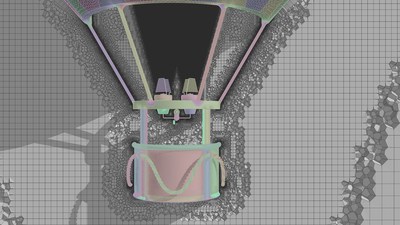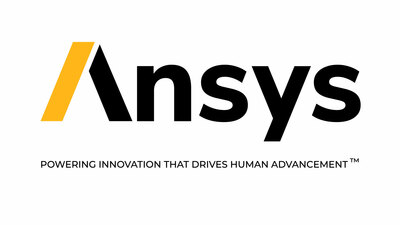ANSYS Pervasive Engineering Simulation solutions empower companies across industries to retain engineers
PITTSBURGH, Jan. 29, 2019 — (PRNewswire) — ANSYS (NASDAQ: ANSS) is making simulation even more pervasive through the ease of use and new functionalities of its newly released ANSYS® 2019 R1. From a revolutionary user experience in ANSYS® Fluent® to hyper-accurate additive manufacturing solutions to the introduction of groundbreaking capabilities in the new ANSYS® Motion™ product line, ANSYS 2019 R1 enables engineers at every level to develop the most innovative products across a multitude of industries.
Megatrends like 5G, autonomous vehicles and electrification are radically changing the product development landscape, making it difficult for companies to retain engineers who can keep pace. The new capabilities across ANSYS' entire simulation portfolio empower engineers, regardless of level of expertise, to simulate from beginning to end faster and more intuitively, maximizing their productivity.
"ANSYS' multiphysics solutions enable engineers to keep pace with increasing demands despite decreasing budgets, training and timelines," said Shane Emswiler, vice president and general manager for ANSYS electronics, fluids and mechanical business units at ANSYS. "With the unparalleled improvements in ANSYS 2019 R1, ANSYS ushers in the next generation of Pervasive Engineering Simulation and enables engineers at every level to adopt simulation more seamlessly across the entire product lifecycle."
With ANSYS 2019 R1, engineers can iterate concepts, simulate results and validate designs faster and easier without sacrificing power or accuracy.
Highlights of the release include:
New User Experience
ANSYS 2019 R1 introduces a new ANSYS Fluent user experience built on top of its proven solver that improves the workflow process without compromising accuracy. Engineers will benefit from the complete, single window solution within ANSYS Fluent, offering speed and simplicity at every step. The new experience streamlines the ANSYS Fluent workflow for generating a mesh from imported computer-aided designs and removes usability barriers for common tasks — enabling users to iterate faster with less training.
User-focused enhancements enable more problem-solving. Task-based workflows with parallel processing can now be used to generate Mosaic-enabled Poly-Hexcore meshes up to 10x faster so users can complete more simulations in less time.
"Mosaic technology enabled Fluent Meshing Workflow allows us to reduce the preprocessing time of our electric generator thermal simulations from six to eight days to four hours," said Itsaso Auzmendi-Murua, research and development thermal research engineer, INDAR. "It provides us an automated and robust preprocessing tool that accelerates our thermal designs and translates into more confident predictions about the future performance of our generators."
"Mosaic-enabled meshing technology enables us to reduce mesh size by up to 30 percent, mainly in large sizes. Mosaic, along with ANSYS' task-based watertight meshing workflow, speeds the setup and the mesh generation process so we can create high-precision meshes faster, even in complex geometries," said Pablo Fernandez, research and development manager at Schako Iberia. "These are the most remarkable advancements in meshing technique in recent years and we estimate that they will reduce our development time by up to 15 percent."
New Product Line
New to the ANSYS portfolio, ANSYS Motion is the most powerful multibody dynamics (MBD) solution on the market. Developed by South Korea's
Virtual Motion, Inc., ANSYS is now making this industry-proven technology available to its global users. The third-generation MBD solver offers a full suite of dynamic capabilities for both rigid and flexible bodies. The product line features an extensive range of powerful application-based toolkits — enabling users to model complex mechanisms, including drive systems and vehicle handling, with ease.
Next-Generation Capabilities for Electronics
New offerings in the electronics and electromagnetics suite include EMI Scanner, electromigration analysis and noise-vibration-harshness (NVH) capabilities. EMI Scanner is a new feature within ANSYS® SIwave™ and ANSYS® HFSS™ that can quickly identify areas of potential electromagnetic interference on users' printed circuit board designs prior to simulation — eliminating errors and speeding time to market. In ANSYS SIwave, electromigration analysis enables users to predict mean time to failure for on-chip and advanced electronic packaging structures. NVH is a new workflow that includes ANSYS® Maxwell®, ANSYS® Mechanical™ and the acoustic solver coupled together through ANSYS® Workbench™. The workflow calculates the electromagnetic noise of a machine when it vibrates due to electromagnetic forces — producing a complete noise profile of an electrical machine within hours.
Improving Structural Analysis Efficiency
A new solver advancement significantly improves how users solve assemblies with contacts, enabling engineers to leverage high performance computing (HPC) and complete certain models more than twice as fast. ANSYS Mechanical also adds thermal compliance to its built-in topology optimization capabilities, empowering users to generate designs that maximize heat transfer.
More powerful than ever, ANSYS Mechanical accurately solves difficult, nonlinear mechanical problems. Enhancements in fatigue crack growth and nonlinear solver re-meshing to solve highly deforming geometries mean more complicated models can be solved with ease. A revolutionary thermal analysis technique uses mixed element types to reduce complexity by 5X without sacrificing accuracy, which is crucial for solving challenging electronics packaging and circuit thermal models.
Powerful Metal Additive Manufacturing Solutions
With breakthrough updates to the ANSYS® Additive Suite™, including a new product, ANSYS provides the most powerful simulation solution on the market for metal additive manufacturing (AM). The newly released ANSYS Additive® Science™ delivers an exploratory environment for engineers to determine the optimum process parameters for metal AM machines and materials — helping users understand how changes to machine parameters affect meltpool sizes and material porosity. Within the existing tools, ANSYS® Additive Print™ widens the range for supported materials and is faster with improved robustness for thin-walled structures. ANSYS® Workbench Additive™ increases accuracy while maintaining reasonable model sizes through a new meshing option - layered tetrahedral elements - that significantly impact model fidelity in geometries with fine details.
"We help customers optimize geometries for additive manufacturing across industries, from aircraft to energy to oil and gas. Using ANSYS Additive Print to simulate how materials will behave during the printing process, we shorten the development process and reduce the cost of trial and error," said Sven Donisi, managing director, Rosswag Engineering. "ANSYS enables our customers with more freedom to design and create new alloys with less risk."
Enhanced Embedded Software
The embedded software suite brings new and enhanced capabilities for automotive applications, including autonomous vehicles, for multicore code generation and testing. The enhanced workflows and features empower users to design and deliver safety-critical products faster with less engineering effort and reduced cost and time to certification, regardless of industry.
Improvements to SCADE® Suite for automotive applications make it simpler and faster to comply with industry standards like AUTOSAR and ISO 26262 when developing model-based systems and software for autonomous vehicles.
With new enhancements, users can reduce testing costs and speed up certification by achieving model and code coverage in a single activity. The release couples efficiency and error finding with an exclusive tool that enables users to achieve both model and code coverage for embedded software applications in just one activity.
"The latest version of ANSYS SCADE Test provides us with a number of improvements enabling huge savings in both effort and time during the testing phase of our product development process," said Christine La Porte, flight control application software engineer, Dassault Aviation. "We will use this new version of SCADE Test for both our current and upcoming projects to enhance our time to market."
Enabling Safer Systems
In the systems suite, ANSYS® VRXPERIENCE® integrates two new camera models enabling users to test the perception algorithm in night driving conditions. The new models also validate automotive systems in dangerous conditions that are complicated to reproduce in physical tests. VRXPERIENCE also includes advanced simulation of scenarios with traffic and vehicle dynamic for head lamps, sensors and HMI use cases, and the product now contains a SCADE plug-in interface allowing users to get faster rapid prototypes for lighting or ADAS control laws.
With new features in ANSYS® medini analyze, users can more quickly and accurately perform functional safety analysis for DO-178C and other standards on aircraft systems. The new ISO PAS 21448 on Safety of the Intended Functionality (SOTIF), in combination with ISO 26262, addresses unreasonable risks in the absence of the malfunctions of the electric and electronic (E/E) systems in automobiles and other land vehicles. SOTIF issues are especially important for advanced driver-assistance systems and autonomous vehicle (AV) systems. New capabilities in ANSYS medini analyze enable automotive and AV users to perform SOTIF-related analysis of E/E systems.
Optical Updates
In the optical suite, ANSYS® SPEOS® strengthens predictive design capabilities for creating, testing and validating a virtual design in a fast iteration loop. ANSYS SPEOS also ensures compliance with international standards and regulations including SAE International, the International Electrotechnical Commission and Insurance Institute for Highway Safety. The ANSYS SPEOS Head-Up Design and Analysis add-on enables users to anticipate and simulate perception issues like blurry images at a very early development stage — drastically reducing the need for time-consuming and expensive physical prototypes.
"Oceaneering provides remotely operated vehicles to more than half of the world's offshore oil rigs," said Todd Newell, vice president of technology, Oceaneering. "We are developing our next-generation, autonomous vehicle using a combination of ANSYS flagship products, optical and embedded software solutions to test designs and validate algorithms for obstacle avoidance."
Expanded Physics Capabilities in 3D Design
In the 3D design suite, ANSYS adds topology optimization to ANSYS® Discovery™ Live – taking a leap forward in making digital exploration and generative design accessible to every engineer. Through real-time shape optimization, engineers can take their ideas to a new level by drastically reducing weight, while retaining strength and creating shapes not previously possible. These capabilities are delivered with the award-winning speed and ease of use associated with Discovery Live. ANSYS® Discovery™ AIM® expands its physics capabilities by adding a random vibration solution, a common and useful feature for engineers in the aerospace and defense industries. Engineers can now observe the likelihood of a certain displacement or stress due to excitation within a range. ANSYS® Discovery™ SpaceClaim® now includes two beta features targeted at creating and parameterizing any concept model by including sketch constraints and feature tracking.
About ANSYS, Inc.
If you've ever seen a rocket launch, flown on an airplane, driven a car, used a computer, touched a mobile device, crossed a bridge or put on wearable technology, chances are you've used a product where ANSYS software played a critical role in its creation. ANSYS is the global leader in engineering simulation. Through our strategy of Pervasive Engineering Simulation, we help the world's most innovative companies deliver radically better products to their customers. By offering the best and broadest portfolio of engineering simulation software, we help them solve the most complex design challenges and create products limited only by imagination. Founded in 1970, ANSYS is headquartered south of Pittsburgh, Pennsylvania, U.S.A., Visit
www.ansys.com for more information.
ANSYS and any and all ANSYS, Inc. brand, product, service and feature names, logos and slogans are registered trademarks or trademarks of ANSYS, Inc. or its subsidiaries in the United States or other countries
Contact | Media | Mary Kate Joyce |
|
|
| 724.820.4368 |
|
|
| |
|
|
|
|
|
| Investors | Annette N. Arribas, IRC |
|
|
| 724.820.3700 |
|
|
|

![]() View original content to download multimedia:
http://www.prnewswire.com/news-releases/ansys-2019-r1-delivers-speed-and-ease-of-use-for-engineers-solving-next-generation-product-challenges-300785235.html
View original content to download multimedia:
http://www.prnewswire.com/news-releases/ansys-2019-r1-delivers-speed-and-ease-of-use-for-engineers-solving-next-generation-product-challenges-300785235.html
SOURCE ANSYS, Inc.
| Contact: |
| Company Name: ANSYS, Inc.
Web: http://www.ansys.com Financial data for ANSYS, Inc. |
